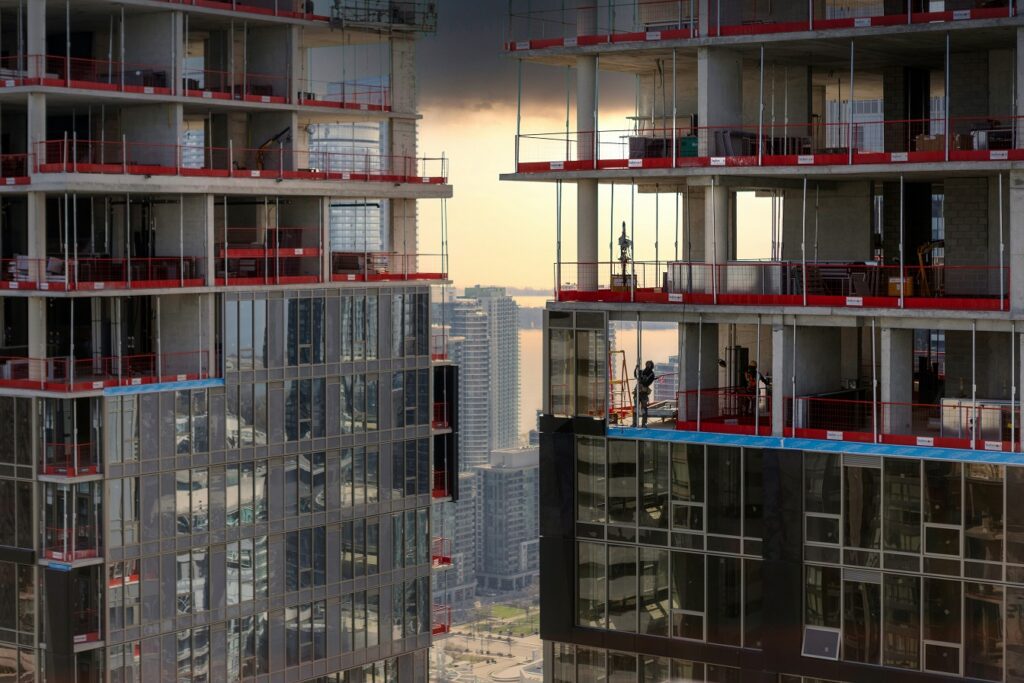Be honest: it’s kinda nice to be back in the office today, isn’t it?
I mean, the time off was great and all. But there was just a bit too much family time, right?
If we could collect one dollar from everybody in this city who lamented spending time with their in-laws over the weekend, we could probably by a pretty nice detached home in midtown, and there are even more folks out there who felt the same way but just didn’t want to admit it.
For the record, my hand is raised. I’m glad to be back in the office. Three days off was plenty.
But I’m not complaining about in-laws, like most other people I spoke to this weekend. My complaint has to do with all the driving.
Er, I mean, driving and farms…
Raise your hand if you visited a farm this weekend?
Alright.
Now raise your hand if you visited two farms this weekend?
For the record, my hand is raised.
It was Brooks Farm on Saturday and then Pingle’s Farm on Monday, and now we have more apples than we could possibly eat as well as over-priced pumpkins that will be food for the raccoons within the next few days.
And what of the children? Well, they always want to go to the farm, even when you explicitly tell them that it’s far – and it takes time to get to, but that doesn’t stop them from complaining both on the way there and on the way back.
Never have I ever felt more like a 44-year-old dad than I did over the weekend, but writing about it here on my blog, where I started writing when I was single and 27-years-old, makes me feel even more like a mid-40’s father of two…
I didn’t actually get into the office until Monday afternoon, if you can believe it.
My hands still freezing from the 7-degree temperature at Pingle’s, I can’t hit the keys on the keyboard with the same authority I’m accustomed to.
And I’m only now catching up on my weekend reading!
The article that made the biggest impact over the weekend, you ask?
It’s not even close.
Three blog readers and two family members emailed me this one:
“The Condo Catch”
Investors have wreaked havoc on the Toronto condo market, leaving us with tiny units no one wants. But without them, the city can’t get the housing it needs. Is there a better way?
The Toronto Star
Friday, October 11th, 2024
You may have seen this come up in your news feed with a different title or byline.
I don’t see “The Condo Catch” anywhere but the Star home page, and this is how the article typically shows online:

If you have a Toronto Star subscription and you can read this on your laptop, the first thing you’ll notice is the necessity of scrolling down the page in order to get to the article, so that the graphics can show the Toronto skyline continuing to add more and more condos.
Then comes the title “The Condo Catch,” which really only appears on this page, as the article has been called “How Investors Have Wreaked Havoc On Toronto’s Condo Market” in all of my news feeds.
In any event, the point is made.
There’s surely no confusion about the angle the authors are taking or the conclusion which the article draws.
“Investors have wreaked havoc.”
Maybe.
Or maybe, just maybe, this is a classic case of “the chicken and the egg.”
I’ve done this bit on TRB before so excuse the lack of originality, but it seems there are a lot of folks who comment on the real estate market who also lack originality. In this case, to “blame” investors for the size, style, and price of condominiums in 2024 completely ignores that every coin has two sides to it, and if you flip it over and over, each side will land exactly fifty percent of the time.
It’s my contention that this article, like so many before it, seeks to lay “blame” in the wrong area.
Way too often, we choose easy targets or attempt to draw sexy, headline-catching connections.
In this case, we’re being told that it’s condo investors who have driven up prices and caused condominiums to shrink, and not developers, and most certainly not the free market.
So let’s start slow. And small.
Let me simply show you the headings in the Toronto Star article, which resemble a trail of bread crumbs left for the likes of Hansel & Gretel…
“In the 1980’s condos were growing in popularity but hadn’t taken off. Now, condos are the main driver of housing growth in Toronto.”
Yes, this is true.
But this seems to hint that a further argument will be made about why condos are the main driver of housing and that there’s something untoward.
Or maybe it’s hinting that there’s something more complicated?
In reality, it’s very, very simple: condos are the main driver of housing primarily because we’ve run out of land.
If there was nothing but forest from the Don Valley Parkway through to Ajax, well then by golly, we could build more houses!
But this isn’t 1945. The land is already built upon.
Do you know what there’s still a lot of?
Sky.
That’s why we’re building there, and even then, Toronto has run out of empty parking lots in the downtown core, so the cost of that land has skyrocketed, and this is one of many reasons why condos cost more today.
So why are people acting surprised that condos are the driver of Toronto’s housing growth?
I don’t hear the New York Times complaining, “There aren’t any detached, single-family homes being built in downtown Manhattan in 2024,” let alone complaining that we aren’t seeing enough affordable ones.
“A big reason for that growth is investors.”
Yes, this is true.
Investors love to buy condos.
But are investors buying what’s being built or are developers building what investors are buying? This is a chicken-and-egg equation that we’re not all going to agree on.
Investors also like to buy what’s cheapest.
But why is this surprising?
Have you seen those television ads for fractional ownership of shares of stock?
Yes, that’s what the world needs now.
Imagine an “investor” who doesn’t have enough money to buy one share of stock so we’re now offering fractional ownership, and blasting television with commercials that glorify a young woman “owning part of a Hollywood studio” because she bought 1/8th of a share of Paramount.
Bravo.
So yes, many investments with a low barrier to entry and/or a low cost of entry will gain more investors than the alternative, but I would add that if there were more freehold homes being built in the GTA, there would be more investors for those properties as well.
“Investors own almost 60 per cent of condos built since 2016 – and they’ve been dictating what gets built.”
Here’s where the article starts to make its point – one that we could tell was coming.
But this is also where I start to take issue because the idea that “investors dictate what gets built” is a conclusion that many want to come to, rather than finding a conclusion that they don’t like.
Above all, this conclusion lets other stakeholders off the hook.
That is the problem I have with this article, and don’t get me wrong – it’s an amazing article! The statistics they’ve compiled are exceptional as is the presentation, save for all the scrolling, but that’s inconsequential.
There are a lot of problems in our city, province, and country with respect to housing, and that’s completely across the board. This is past, present, and future. This is in major cities and in small towns. This is at the municipal, provincial, and federal levels, and this is in all housing price points as well.
But to suggest that investors “dictate what gets built” is a unique way of describing how condos are planned, approved, built, financed, and taxed in this city.
“Investors wanted smaller condos with better cash flow. But now over-leveraged investors are trying to off-load their tiny units, and end users don’t want them.”
As is the theme so far, all three of these points are correct in an end-around fashion, but directly, and at face value, they’re incorrect.
Investors never wanted smaller condos; investors wanted an absolute price point, and as real estate values increased, developers made condos smaller to increase the relative price but keep the absolute price the same.
Another clarification here: over-leveraged investors are trying to offload all units; not just tiny ones.
And this idea that “end users don’t want” the small condos could have to do with the size of the units, alright.
But we could also say:
- End users don’t want any condos right now, as evidenced by the historically low sales figures in the condo market.
- End users can’t afford condos right now.
- End users can afford condos right now but are waiting until interest rates decline, like so many other participants and onlookers in the condo market.
- End users in this entry-level space might be suffering from entitlement, as we have discussed before.
The article seems to infer that only over-leveraged investors of tiny units are attempting to off-load them, as also seems to infer that end users don’t want them only because they’re “tiny.”
Remember this article that I wrote in the summer?
August 26th, 2024: “Are Smaller Condo Sizes Breeding Intelligence Or Entitlement?”
In this blog post, I referred to a study that noted: 77% of Canadian renters wanted to buy a single-family home, but just 12% wanted to buy a condo.
But it’s important to note the word “want.”
It’s also important to note that the 12% figure dropped to 8% for respondents aged 18 to 24, but do we really care whether a 21-year-old “wants” a single-family home versus a condo?
So I reject the notion that “end users don’t want tiny condos” as a function of need and I reject this as evidence that condo investors have “wreaked havoc” on the city of Toronto.
“There’s a lot of housing out there that’s too small for end-users, and that’s a problem, experts say. Especially, because Toronto is facing the worst housing crisis in its history.”
Again, this goes back to wants versus needs.
“Too small” for end users.
Says who?
My wife’s cousin, who lives in Manhattan, told me “If an apartment is above 350 square feet in lower Manhattan, that’s considered luxurious. If a single person is living in a space that’s 400 square feet or larger, we generally assume they’re loaded.”
Honestly, I will be the first person to admit: I don’t want to live in 350 – 400 square feet. But my point is twofold:
- Needs and wants are different.
- This doesn’t have anything to do with “investors deciding what’s built” in Toronto.
Now, the fact that this quote continues, “…Toronto is facing the worst housing crisis in its history,” is attempting to create a cause-and-effect that’s super sexy from a media standpoint, but again, hardly accurate.
Investors did not create “the worst housing crisis in Toronto’s history.”
As I said previously, this line of thinking let’s many stakeholders off the hook.
Then the grand finale:
“So how can the condo market get units built and ensure consumers aren’t vulnerable to the whims of investors?”
Again, consumers aren’t vulnerable to the “whims of investors.”
Consumers are vulnerable to supply and demand.
Consumers are vulnerable to market forces.
Consumers are vulnerable to public policy.
And while this Toronto Star article does have some fantastic statistics, charts, and graphs, the conclusion is all wrong.
Let me provide a few more excerpts and more commentary:
“At the same time the share of investor-owned units rose, the size of the floor plans shrunk. In the last few decades, Toronto’s condos have become almost half the size as the private sector pushed to maximize profit with smaller units.”
Now I’m able to envision the target audience for this article and the theme therein.
Anybody who believes, corporations shouldn’t be concerned with making a profit simply doesn’t understand economics.
But those folks exist out there! They think that businesses should operate at break-even, or even a loss. I mean, not their business or their mother’s business, but you know, places like Amazon and the like.
I reject the notion that “developers trying to make a profit” is a reason for the plight of our housing market, and I always have.
The words “private sector” above indicate that maybe we should look at the other side of the coin? Maybe we should consider how the public sector factors into all of this?
As we know, and as the article details, the public sector has simply sat back and done next to nothing while the private sector built all the housing in the past two decades.
So then why is nobody pointing the finger at the public sector? Why is it “developers operating in search or profits” who get the blame?
Here’s another excerpt:
“A perfect storm has put the condo market in the path of a future supply drought – investors aren’t buying units, interest rates are still too high, and construction and material costs have soared. That’s going to lead to a shortage of homes – especially rentals – down the road.”
Ah, yes, the perfect storm. Every time there’s a problem, we have the benefit of hindsight that allows us to look back and find a multitude of reasons, some of which intersect, and some that don’t, to indicate why that problem exists.
In this case, it’s just a simple catch-22.
We don’t want developers to build only small condos, even though investors are financing condo construction, and investors want smaller/cheaper condos.
But we don’t want developers to stop building condos, since that would result in a massive shortage of homes in the near future.
What’s the solution?
Thankfully, it’s offered at the end of the article:
With the majority of new condos being pre-sold to investors, experts say it’s time to have a more balanced market with supply not being dictated by investors looking to make a profit. That means creating a diverse range of condos and apartments of various sizes, and ensuring that a steady stream of supply enters the market at all times.
Excellent idea!
Except, well, it won’t work, because it’s fantasy and it ignores reality.
It ignores the relationship between supply and demand.
In any market, there must be an overlapping of supply and demand in order for that market to function efficiently, if at all.
If tomorrow, Toyota started to only produce cars that were the colour yellow, surely we would expect the demand for Toyota cars to decline, right?
If developers were somehow “forced” to build 50% of their units as 1,400 square foot, 3-bed, 3-bath condos, then developers would never sell the units.
And here’s the problem, as we’ve discussed so many times before:
Developers don’t build condominiums until a sufficient number of units are pre-sold.
If a developer doesn’t sell 70-80% of the units, then the banks don’t finance the project, and the project is never built.
That is what’s missing in all of these “ideas” to solve the housing crisis.
That, and of course, price, since those newly-built 1,400 square foot condos, often touted as “good for families,” will cost $2,000,000.
Interestingly enough, the article does note that condos aren’t built unless units are pre-sold, however, they seem to come to a different conclusion than I do. They seem to simply say “yeah, but,” and continue down the path of “we need to build this and that instead…”
The article also notes, and underlines:
Just 3% of condos completed in 2023 were three-bedroom units.
However the article does not look at the demand for three-bedroom units, nor does it look at the demand at market price.
This is an essential part of the conversation!
To ignore this is to step out of reality and into fantasies that start with, “In a perfect world, I wish…”
And just to be sure – we’re not talking about forcing developers to sell condos for half the cost to build them, right? If so, then this is a completely different conversation.
The cost of building condos has never been higher.
Land, materials, labour, taxes, and financing have run the cost over $1,100 per square foot.
So who is buying these 1,400 square foot, 3-bed, 3-bath condos at $1,500 per square foot?
And if nobody is buying them, then why are there calls to build them?
Listen, I have no problem with the public sector building tens or hundreds of thousands of affordable homes. But calls on the private sector to not only deliver a product for which there is no demand but do so at a price that’s a financial impossibility, is beyond naive.
But even if the pre-sell financial model that condominium developers employ in the GTA didn’t exist, and even if banks – or somehow, the CMHC, were to finance projects before they were pre-sold, would it change anything?
Would developers build larger units?
Again, it depends on the demand for the larger units.
That, of course, depends on the price.
And what does the price depend on?
The cost to build.
So why aren’t people looking at the cost to build as the origin of everything that’s wrong with the condo market, rather than the end result?
It all starts here, folks.
Whether we’re talking about how to ensure larger condos get built or whether we’re talking about housing affordability in general, it all starts with the cost to build.
Which of the following could we see reduced in order to lower the cost of building?
Land. Privately owned land will always sell for the market rate. Is there publicly owned land that could be offered to private-sector developers, or could the public sector build on these lands?
Labour. There’s no way to reduce this cost, is there? And if there were, would anybody like it?
Materials. How do we lower the price of materials? I suppose removing HST from the purchase is an option. It’s the only one I can think of.
Approvals. As I noted in a blog post last week, the cost of delaying a development is massive and it’s passed along to the consumer. Here’s an area where I really think a difference could be made.
Taxes. This comes as no surprise to my regular readers, but with upwards of 30% of the price of new homes consisting of some form of taxation, this is the easiest way to bring down the cost, and/or incentivize the private sector to build. Don’t kid yourselves though; the government has to take from Peter to pay Paul, so reducing the City of Toronto development charges on new construction would simply result in a new or increased tax elsewhere.
Now, what about other ideas to indirectly improve housing affordability?
Are there any other stakeholders in this?
Three topics that to which I’d like to open the door:
Infrastructure. If we had supporting infrastructure that allowed for greater, faster, and more efficient movement through the Golden Horseshoe, ie., roads, highways, trains, subways, and the like, then people could “afford” to live further away and not be impacted by reduced quality of life.
Foresight. If a city’s government can plan ahead for, say, an Olympics that’s 9-years-away, making necessary improvements and building necessary infrastructure, then why in the world can’t a city’s government plan for an expanded population in ten, twenty, or thirty years? All three levels of our government have always been reactive when it comes to urban planning rather than proactive.
Public sector investment. I’m not talking about writing cheques in terms of “investment” but rather I’m talking about a public sector that takes a greater role in actually building units of housing. As the Toronto Star article and many others like it have noted, the public sector essentially stopped building housing in the 1980’s and 1990’s. So why are people always finding fault with the private sector and what they build, how they build, and the price of what they build, rather than asking what their public sector is doing for them – or isn’t?
Well, I think that’s it for me today, folks!
Or should I say, tonight…
It’s time to leave the office and head home for some yoga, to help me relax, followed by some time with the tired and crabby children, to help me forget the temporary calm that yoga provides.
I wish that today’s conversation could have been more positive or at least presented that way! But we all have our opinions on the “plight” of the housing market and I’m just as passionate about my beliefs as the next person, even if that means disagreeing with the sentiments offered in a major daily newspaper here in the city.
As always, I encourage people to read as much as they can on the subject and not take one person or one source’s opinion, whether it’s that of a newspaper, or even mine…
Namaste!
































Steve
at 11:46 am
David has written a very insightful response to the Toronto Star article. In a related housing topic, in to-day’s Toronto Star article by Rosie DiManno on the recently completed supportive housing project in Parkdale, this is the type of project, hopefully to be duplicated in Toronto’s suburbs as well, that needs public and private charitable based funding, to assist the vulnerable folks that need a roof over their head. Meanwhile the future to-be-built condo apartment market is going to languish for years. I hope the many developers that have assembled several sites in the Yonge North corridor between Finch and Steeles Avenue have lots of patient money. There going to need it even with average household size still shrinking somewhat.
Ace Goodheart
at 1:33 pm
Interesting take on this.
I would disagree that end users are not “vulnerable to the whims of investors” (or however they said it). When purchasing a house, back in 2021, you hated the investors. Because they were loaded, they were very aggressive and they could always out bid you.
You learned, when offering on houses, that the easiest way to be successful was to offer on a house that investors did not, and would not, want. The trick was finding that unicorn. Maybe it was full of rooming tenants that looked like they would put up a fight and not leave. Maybe it had an expensive problem, like a damp basement that required a dig down, or plumbing and electrical from the 1940s. One way or another, if you could find that special house, then you would not be competing with investors and you could probably be successful on offer night.
So many houses that I bid on, went to investors. How did I know? House sigma. You can track the post sale activity on a house. They all sold (way over asking) and then within a month or two they were put up for lease. The buyer had no intention of living in the house and was buying it as an investment, and then they immediately leased it out.
I would also agree that condos in Toronto are not really “small” by global standards. I have lived in Asia, and I can tell you that particularly in Seoul and in Hong Kong, man, the condos are small. I had a friend in Hong Kong who showed me his condo. You could fit two people in it, shoulder to shoulder. Some of them were smaller than that. I heard of ones that you could sleep in, but not stand up.
When I visited a friend down in New York, her apartment was a bedroom and a kitchen. When I had to use the bathroom, it was down the hall and shared with all the other apartments on that floor.
Toronto Condos have private bathrooms. So that is something.
Marina
at 3:48 pm
Well, you said the quiet part out loud, David. People don’t just want three bedroom condos. They want three bedroom condos that are
1) large – so min 1500 sq feet
2) cheaper than a detached in the burbs – so less than a million
The only real solutions here are infrastructure and more remote work. Basically make it possible for people to live elsewhere.
Unfortunately nobody would touch that because they want to prop up commercial real estate prices.
In any event, my problem with most of these articles is that they are full of wishful thinking. You can’t build real solutions on a hope and a prayer.
Sue
at 8:42 am
It’s obvious that the author of the Star article has not done a lot of historical research into lack of housing in Toronto. For example, I have seen an ad signed by the mayor of Toronto in the 1940s warning people not to move to Toronto as there was no housing available. How can this continue to be an issue?
Sanh
at 2:32 pm
I always here about how the government should help make “homes affordable”. No, that’s not what they should be doing. They should be doing all they can to make prices go up. Prices going up is indicative of a healthy and robust economy. Not going down. Don’t cater to the lowest common denominator, cater to the money. Homes and Lands are limited. What that means is, not everyone can own them. That’s a fact, and it’s also a reality in many other parts of the world. If people can’t buy homes, that’s on them and their situation. That’s got nothing to do with the people who were able to take the steps to buy a home. They need to hustle harder, need to make sacrifices in order to obtain what they want. Move further out and work your way in. Get roommates. Share a mortgage. Do everything it would take in order for you to get your own place. Not willing to do it? That’s on them, not anybody else.
TOPlanner
at 9:12 am
Agreed on infrastructure and public sector investment.
For foresight, governments are regularly planning for 30 years ahead. See the Toronto Land Needs Assessment for example, which forecasts population and employment growth until 2051: https://www.toronto.ca/city-government/data-research-maps/research-reports/planning-development/land-needs-assessment/
those forecasts are shared by City Planning with Transportation, Toronto Water, the TTC, etc, to help plan for future infrastructure needs.
The problem is that’s it very challenging to predict the future. We know that the last few years have included pandemics, wars, changes to federal immigration policy, quick financial market cycles which all impact population and the economy. Of course you can forecast different scenarios and try to build in risk, but it is very hard to account for unknown unknowns and make a perfect guess.
Bryan
at 2:46 pm
This is exactly the type of discourse that is needed on real estate… but I am saddened by the editor who changed the title of this article to make it more clickbait. I personally think something between what the article said and what David argues is the truth.
You definitely can’t just force builders to build bigger units. If you increase regulation you are going to increase the cost to build and thus increase prices. The end user that this article hopes will buy these $2M 3-bed units wont be able to afford to buy them and they also wont make sense for investors because they would need to charge absurd rents to be anything close to cashflow neutral. These units wont sell because no one can afford them…. and developers will need to charge more for the smaller units to make up for it which compounds the issue rather than helping. No good.
I also, however, don’t believe for a minute that builders will set prices such that end users can afford them… even if the cost to build them goes down. Builders will charge what people will pay. Over the last 10 years, the market has clearly demonstrated that there is a significant amount of demand at a price higher than what end-users can generally afford. For this to change, there would need to be a massive increase in supply and competition. In spite of having more cranes in the sky than anywhere else in North America for the last million years, that supply driven price drop has not happened. Do we even have enough people in the trades to build the number of condos that makes prices stop climbing over the medium/long term? I don’t think so. If that doesn’t happen, condos will continue to be purchased by mostly investors and prices will remain at whatever level investors can/will pay, regardless of building costs.
So what’s the “fix”(if one is even needed)? Here is my shot at it. Government used to build housing in the GTA. While I don’t think government building works in 2024 (looking at you metrolinx), perhaps partnering with developers would. Instead of declaring that developers must build X% affordable housing to get a permit, maybe the government pays for (by a reduction in development fees) the construction of X% end-user minded units that are made available at a subsidized rate for either purchase or rent. These low cost units will help drive down costs of the “other” units developers build without cutting down profitability (lower fees) and thus without decreasing construction supply.